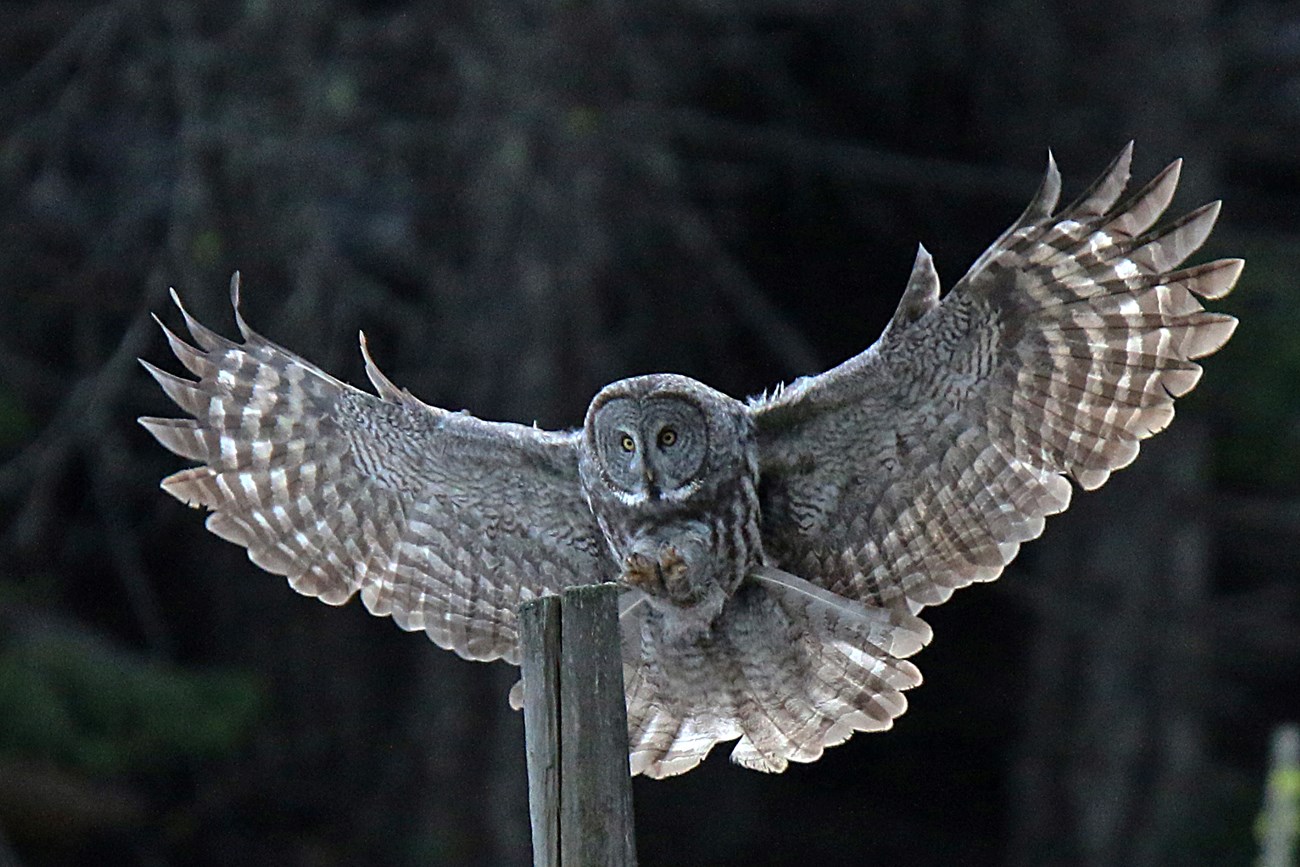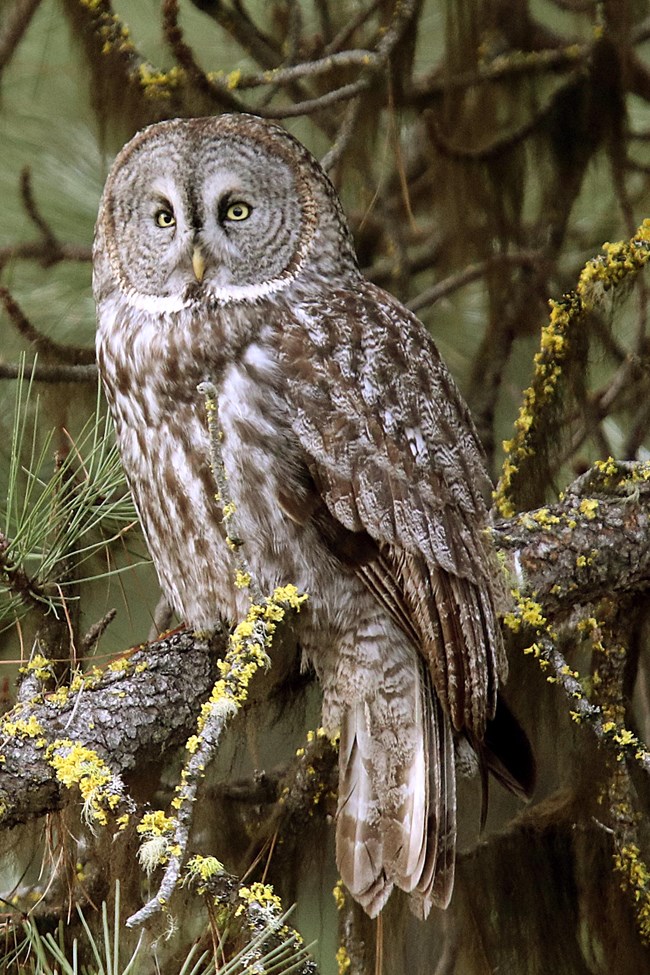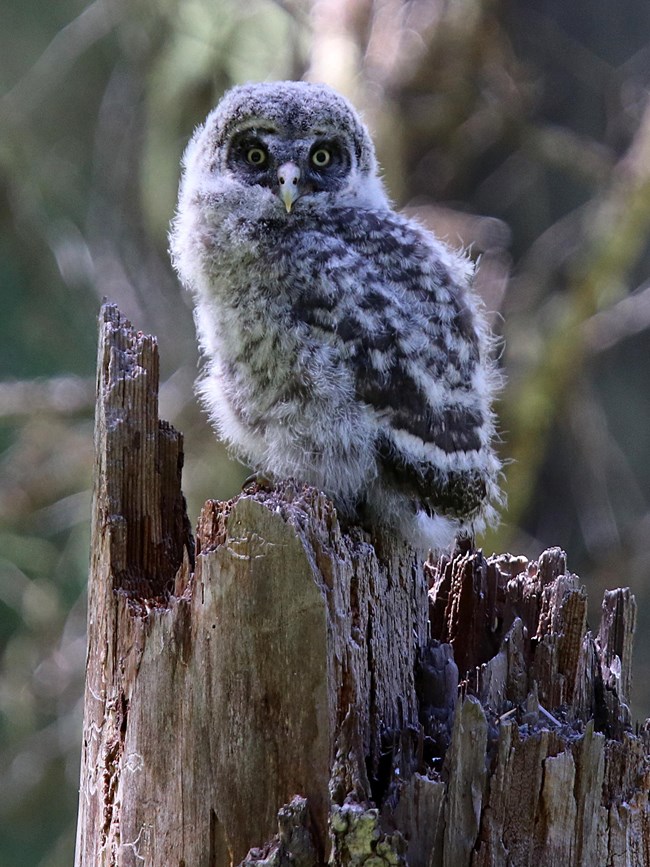Last updated: October 30, 2020
Article
Great Gray Owl

Mel Clements
General Description
Blending perfectly with the gray-brown bark of its conifer perch, the great gray owl becomes one with the forest. No wonder its other names include Phantom of the North, or Great Gray Ghost. Strix nebulosa belongs to the family, Strigidae, along with its close cousins, the barred owl (Strix varia) and spotted owl (Strix occidentalis).

Mel Clements
This tall gray owl, patterned with brown and white mottling, streaks, and barring, sports a large facial disk and yellow eyes. As with all owls, its eyes are immobile, aimed instead by extremely flexible head movements. It lacks ear tufts, and its chin and the space between its eyes (lores) bear prominent white patches. Though taller and appearing larger than the great horned owl (Bubo virginianus) due to its fluffy plumage, it actually weighs less. Its slow, easy flight is described as heron-like.
Habitat and Distribution
Most great gray owls nest in the dense northern boreal forests across North America and Eurasia. The southernmost edge of their range, however, dips down through the Cascades and Klamath Mountains of the Pacific Northwest, into the Sierra Nevada of California and includes the northern Rocky Mountains. Scarce winter food sometimes drives them even further south. They need mature forest habitat with openings that sustain their primary prey: small rodents. In the Pacific Northwest, pine, oak/madrone, Douglas-fir and other forest types bordering bogs, fields, or meadows are suitable.
Diet and Foraging
Great gray owls primarily hunt at night or at dawn and dusk, though they are capable daytime foragers. Voles (Microtus spp.) comprise almost 90% of their diet. Low vole populations, in fact, can significantly lower owl reproduction and trigger mass owl movements south (irruptions) in search of food for the winter. Equipped with powerful hearing, thanks to offset ear openings and a large facial disk, the owls hunt from low perches on the edge of openings. Like most owls, special structures on their feathers—a comb-like filter on the front of flight feathers and a velvety layer across the surface—make their flight almost soundless. They can hear small rodents deep under the snow. They attack with a short or hovering flight over the opening, pouncing feet first towards their prey through the snow. Remarkably, they’ve been known to break through snow crust strong enough to support an 80 kg person! The hapless rodent is swallowed whole. Other prey on the menu for these owls include weasels, robins, grouse, and frogs.
Vocalizations
Great gray owls primarily vocalize during the breeding season. Adults defend their territory with deep, evenly spaced hoos, and may snap their bills at intruding humans. Early on, juveniles make a low chattering. As they grow, their food begging becomes a loud shriek.
Predators
Great gray owl young are vulnerable to forest raptors, like the northern goshawk (Accipiter gentilis) or the fierce great-horned owl.

Mel Clements
Breeding
Great gray owls breed at 2 to 3 years old. A monogamous pair forms in late winter, bonding through mutual preening and courtship feeding. Not nest-builders themselves, they seek out cavities in broken tree tops or stick nests abandoned by other large forest-dwelling birds. The female lays 3 to 5 eggs (more in a good prey year) and incubates them exclusively while the male brings her food. After hatching a month later, the young will stay in the nest for 3 to 4 weeks until leaving it, still unable to fly. During this pre-flight, “branching” period, they climb leaning trees and stay off the ground until taking flight 1 to 2 weeks later. Once fledged, the adult male begins directly feeding the young and the female takes a much less prominent role in their care. After 3 months, the now independent fledglings disperse a few kilometers away to their own hunting grounds.
Conservation
While globally secure, they are a state sensitive species in Oregon and endangered in California. Timber harvest is a threat when it removes the large live and dead trees required for nesting and the dense cover required for protecting new fledglings. Audubon climate change models also predict an overall loss of habitat for great gray owls under future scenarios, potentially moving them north out of the conterminous 48 states.
Where to See
Great gray owls are uncommon in Klamath Network parks, occurring rarely in Crater Lake National Park, Lava Beds National Monument, and Redwood National and State Parks.
Learn More
Call of the great gray owl:
https://macaulaylibrary.org/asset/4543/play
https://www.audubon.org/magazine/fall-2016/after-100-years-scientists-are-finally-starting
Download a pdf of this article.
Prepared by Sonya Daw
NPS Klamath Inventory & Monitoring Network
Southern Oregon University
1250 Siskiyou Blvd
Ashland, OR 97520
Featured Creature Edition: October 2020
Thumbnail image credit: Mel Clements
